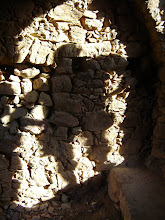I'm sure this happens elsewhere, but I'd like to imagine that this is the sort of thing that only takes place in Netherlands. Spring and summer are popular times for the Dutch to interfere with their traffic circulation system. If it's not roadworks - which seem to start when temperatures hit 10 degrees Celsius and end when the building contractors take their annual leave in July - it's the cyclists.
In Dutch they have two words for cyclist: one is fietser, a category into which I quite happily fit, and wielrenner. The latter are those who race around in packs, dressed in tight-fitting lycra emblazoned with an array of sponsors' names. In high summer, it's not unusual to be driving around, minding your own business, when all of a sudden you'll hear the whistle of an officious looking verkeersregelaar telling you that the road you want to follow is out of bounds for the rest of the day: the wielrenners have taken over.
Okay, maybe I'm exaggerating when I say it happens a lot, and I try to remain philosophical about it. I mean, I'm a foreigner who chooses to live here and should be tolerant towards my host country's predilictions. In general I am, but this weekend - when the Dutch professional cycling championships come to town - takes the biscuit. Not only are the races being held in Heerlen, but last Tuesday, when I received a missive from the council on my doormat, I discovered they're actually coming down MY street. We're talking about two whole days here: on Saturday AND Sunday the street is strictly off limits to car traffic - no bad thing in itself - but, worse still, there's a parking ban, and me and my neighbours who live in this peaceful side-road have been told that our vehicles will otherwise be towed away (presumably at our expense).
Many Limburgers will no doubt enter into the spirit of the occasion and watch the cyclists flash past from the comfort of their own front gardens with a crate of beer. Others will be bemoaning the fact that the organisers (including the local council) have decided to stage the event slap-bang in the middle of the south side of town and will be confined to their homes on what looks like being a warm, sunny weekend.
Right now, I'm thanking my lucky stars that I'd not planned on moving house this weekend or running errands that require trips back and forth to the shops. In fact, secretly, I'm looking forward to my street being a centre of attention tomorrow, but I won't be shouting it from the rooftops, nor will I have a crate of beer.
Who knows? Maybe in a couple of years when I've spent the majority of my years in the Netherlands, I'll give up watching cricket and head off to the nearest cycle store for some lycra - but I seriously doubt it.












